Strategic Analysis of Starbucks: Business and Stakeholder Report
VerifiedAdded on 2023/01/12
|17
|5186
|2
Report
AI Summary
This report provides a comprehensive analysis of Starbucks' business strategy, encompassing its external and internal environments. The external environment is examined through PESTLE and Porter's Five Forces models, evaluating political, economic, social, technological, legal, and environmental factors, as well as competitive forces within the coffee industry. The internal environment is assessed, focusing on Starbucks' competitive advantages and financial performance. The report also includes a stakeholder analysis, identifying and prioritizing key stakeholder groups, and recommending appropriate communication strategies. The analysis covers the company's position within the industry life cycle and offers recommendations for future strategic directions. The report highlights the importance of understanding both the external and internal factors that influence Starbucks' success.
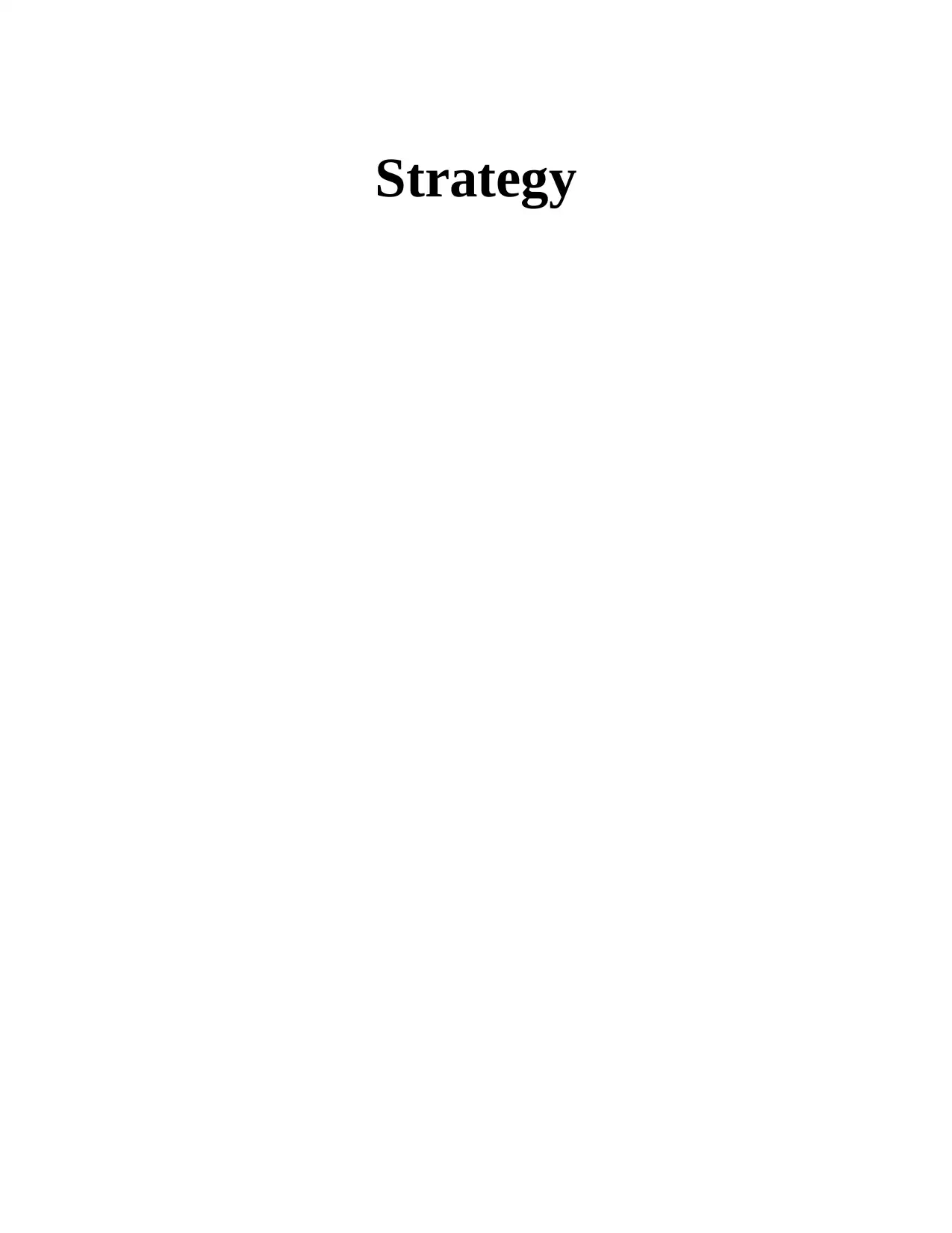
Strategy
Paraphrase This Document
Need a fresh take? Get an instant paraphrase of this document with our AI Paraphraser
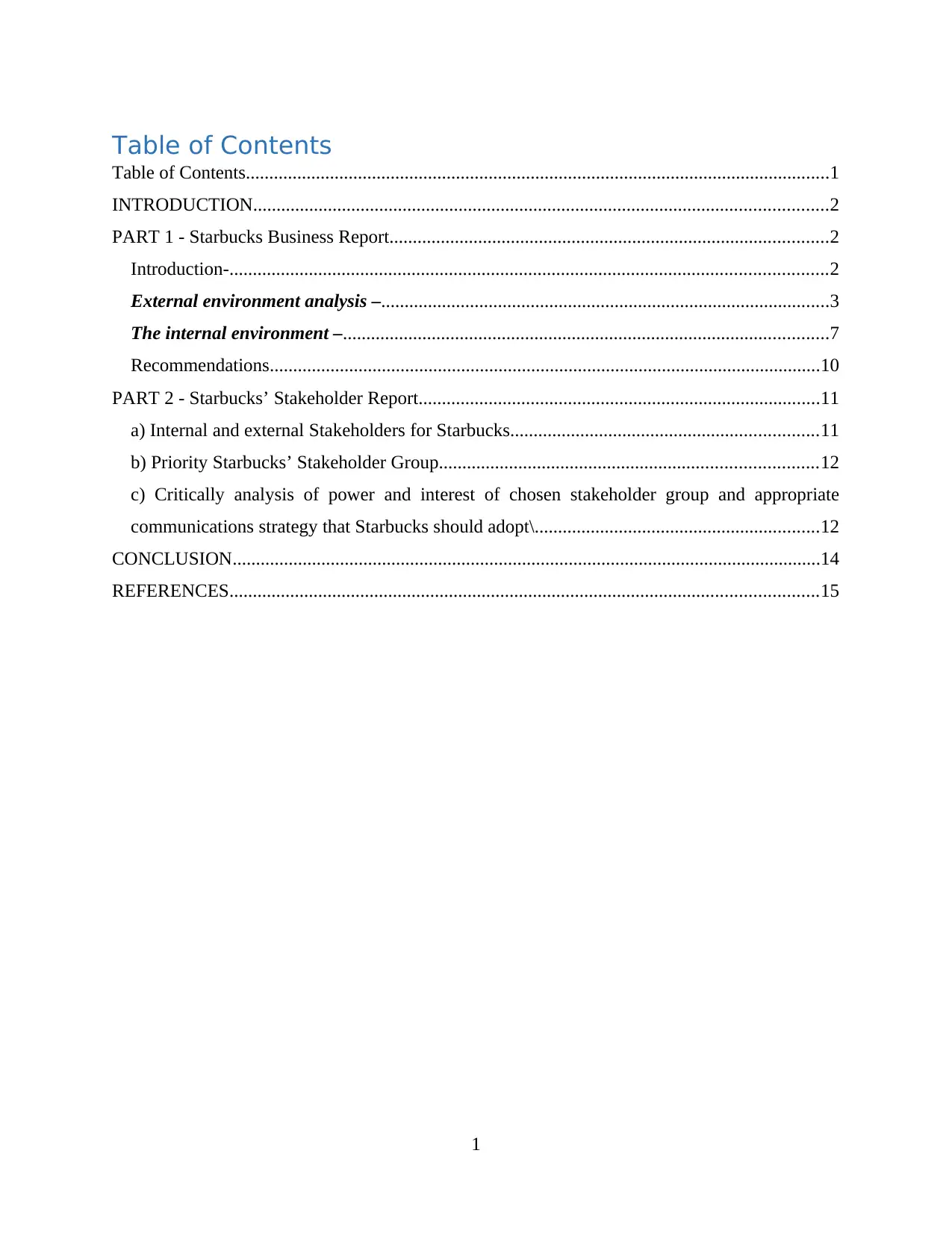
Table of Contents
Table of Contents.............................................................................................................................1
INTRODUCTION...........................................................................................................................2
PART 1 - Starbucks Business Report..............................................................................................2
Introduction-................................................................................................................................2
External environment analysis –................................................................................................3
The internal environment –........................................................................................................7
Recommendations......................................................................................................................10
PART 2 - Starbucks’ Stakeholder Report......................................................................................11
a) Internal and external Stakeholders for Starbucks..................................................................11
b) Priority Starbucks’ Stakeholder Group.................................................................................12
c) Critically analysis of power and interest of chosen stakeholder group and appropriate
communications strategy that Starbucks should adopt\.............................................................12
CONCLUSION..............................................................................................................................14
REFERENCES..............................................................................................................................15
1
Table of Contents.............................................................................................................................1
INTRODUCTION...........................................................................................................................2
PART 1 - Starbucks Business Report..............................................................................................2
Introduction-................................................................................................................................2
External environment analysis –................................................................................................3
The internal environment –........................................................................................................7
Recommendations......................................................................................................................10
PART 2 - Starbucks’ Stakeholder Report......................................................................................11
a) Internal and external Stakeholders for Starbucks..................................................................11
b) Priority Starbucks’ Stakeholder Group.................................................................................12
c) Critically analysis of power and interest of chosen stakeholder group and appropriate
communications strategy that Starbucks should adopt\.............................................................12
CONCLUSION..............................................................................................................................14
REFERENCES..............................................................................................................................15
1

INTRODUCTION
Strategy is the main activity that is required in every stage and organisation. Every
organisation make strategies and planning for running and making higher profits. For organizing
activities and facing competition there is need to make the planning that can help to increase the
productivity and profitability (Abdel-Basset, Mohamed and Smarandache, 2018). This report is
based on Starbucks case study that is American multinational chain of coffeehouses and roaster
reserves that is large size organisation, headquarter in Seattle, Washington. This is considered as
largest coffeehouse in the world. This targeted quality minded coffee drinkers with handmade
coffee based on lighter roasts. Such organisation is operating its business at 30000 locations all
over the world in 77 countries. Every organisation is needed to have strategies which can used to
know a competitor is growing up and how they can face competition in order to attain the
business goals. This report covers report different information about Starbucks, external
environment and internal environment which helped to compete with others. Apart from this,
stakeholder report has been considered in this study that can help to maintain the profitability.
PART 1 - Starbucks Business Report
Introduction-
Starbucks is a well-known name in the coffee world. This organisation was founded by
jerry Baldwin, Zev Siegl and Gordon Bowher who are earning revenues of 16 billion dollars in
the year 2015. This has more than 22,500 stores available worldwide. The brand has gained
sustainability over years of responsible industry, concentrating on customer satisfaction and
product consistency. The main factor for Starbucks' popularity is distinction. There are three
important aspects that make the brand distinct from the others. Price is the first critical factor.
Starbucks is the world's greatest coffee company. This has a strong regional footprint. The brand
is known for its high quality products as well as its excellent customer service and in-store
climate. The business has gained a leadership role in the coffee sector with a strong emphasis on
product consistency, customer satisfaction and outstanding logistics. This organisation is
providing variety of beverages and coffee with delicious taste that attracts customers and
increase organisational productivity (Epstein, 2018). The company only offers high quality
coffee. Starbucks had started his modest tale in Seattle by offering coffee. The major rivals of
2
Strategy is the main activity that is required in every stage and organisation. Every
organisation make strategies and planning for running and making higher profits. For organizing
activities and facing competition there is need to make the planning that can help to increase the
productivity and profitability (Abdel-Basset, Mohamed and Smarandache, 2018). This report is
based on Starbucks case study that is American multinational chain of coffeehouses and roaster
reserves that is large size organisation, headquarter in Seattle, Washington. This is considered as
largest coffeehouse in the world. This targeted quality minded coffee drinkers with handmade
coffee based on lighter roasts. Such organisation is operating its business at 30000 locations all
over the world in 77 countries. Every organisation is needed to have strategies which can used to
know a competitor is growing up and how they can face competition in order to attain the
business goals. This report covers report different information about Starbucks, external
environment and internal environment which helped to compete with others. Apart from this,
stakeholder report has been considered in this study that can help to maintain the profitability.
PART 1 - Starbucks Business Report
Introduction-
Starbucks is a well-known name in the coffee world. This organisation was founded by
jerry Baldwin, Zev Siegl and Gordon Bowher who are earning revenues of 16 billion dollars in
the year 2015. This has more than 22,500 stores available worldwide. The brand has gained
sustainability over years of responsible industry, concentrating on customer satisfaction and
product consistency. The main factor for Starbucks' popularity is distinction. There are three
important aspects that make the brand distinct from the others. Price is the first critical factor.
Starbucks is the world's greatest coffee company. This has a strong regional footprint. The brand
is known for its high quality products as well as its excellent customer service and in-store
climate. The business has gained a leadership role in the coffee sector with a strong emphasis on
product consistency, customer satisfaction and outstanding logistics. This organisation is
providing variety of beverages and coffee with delicious taste that attracts customers and
increase organisational productivity (Epstein, 2018). The company only offers high quality
coffee. Starbucks had started his modest tale in Seattle by offering coffee. The major rivals of
2
⊘ This is a preview!⊘
Do you want full access?
Subscribe today to unlock all pages.

Trusted by 1+ million students worldwide
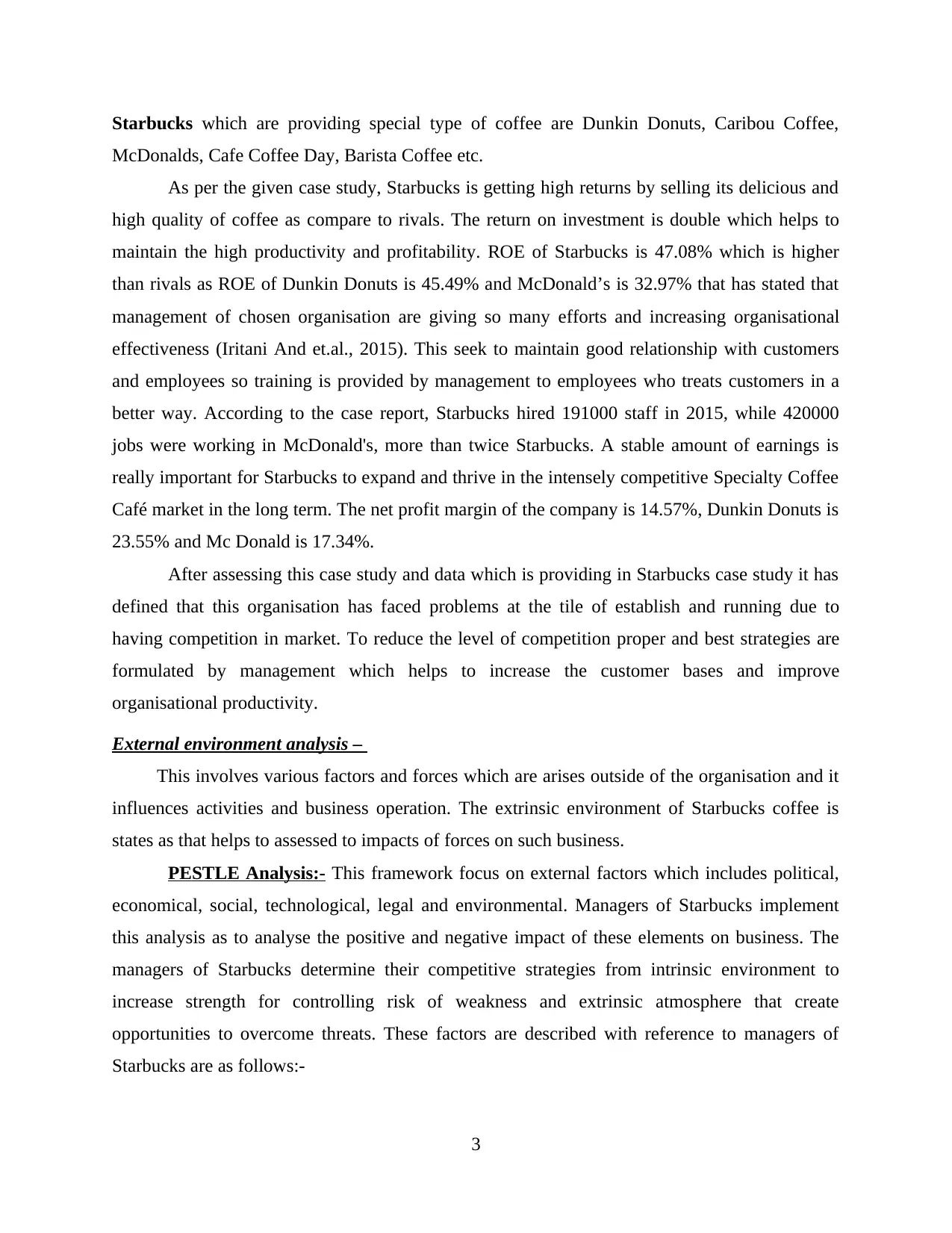
Starbucks which are providing special type of coffee are Dunkin Donuts, Caribou Coffee,
McDonalds, Cafe Coffee Day, Barista Coffee etc.
As per the given case study, Starbucks is getting high returns by selling its delicious and
high quality of coffee as compare to rivals. The return on investment is double which helps to
maintain the high productivity and profitability. ROE of Starbucks is 47.08% which is higher
than rivals as ROE of Dunkin Donuts is 45.49% and McDonald’s is 32.97% that has stated that
management of chosen organisation are giving so many efforts and increasing organisational
effectiveness (Iritani And et.al., 2015). This seek to maintain good relationship with customers
and employees so training is provided by management to employees who treats customers in a
better way. According to the case report, Starbucks hired 191000 staff in 2015, while 420000
jobs were working in McDonald's, more than twice Starbucks. A stable amount of earnings is
really important for Starbucks to expand and thrive in the intensely competitive Specialty Coffee
Café market in the long term. The net profit margin of the company is 14.57%, Dunkin Donuts is
23.55% and Mc Donald is 17.34%.
After assessing this case study and data which is providing in Starbucks case study it has
defined that this organisation has faced problems at the tile of establish and running due to
having competition in market. To reduce the level of competition proper and best strategies are
formulated by management which helps to increase the customer bases and improve
organisational productivity.
External environment analysis –
This involves various factors and forces which are arises outside of the organisation and it
influences activities and business operation. The extrinsic environment of Starbucks coffee is
states as that helps to assessed to impacts of forces on such business.
PESTLE Analysis:- This framework focus on external factors which includes political,
economical, social, technological, legal and environmental. Managers of Starbucks implement
this analysis as to analyse the positive and negative impact of these elements on business. The
managers of Starbucks determine their competitive strategies from intrinsic environment to
increase strength for controlling risk of weakness and extrinsic atmosphere that create
opportunities to overcome threats. These factors are described with reference to managers of
Starbucks are as follows:-
3
McDonalds, Cafe Coffee Day, Barista Coffee etc.
As per the given case study, Starbucks is getting high returns by selling its delicious and
high quality of coffee as compare to rivals. The return on investment is double which helps to
maintain the high productivity and profitability. ROE of Starbucks is 47.08% which is higher
than rivals as ROE of Dunkin Donuts is 45.49% and McDonald’s is 32.97% that has stated that
management of chosen organisation are giving so many efforts and increasing organisational
effectiveness (Iritani And et.al., 2015). This seek to maintain good relationship with customers
and employees so training is provided by management to employees who treats customers in a
better way. According to the case report, Starbucks hired 191000 staff in 2015, while 420000
jobs were working in McDonald's, more than twice Starbucks. A stable amount of earnings is
really important for Starbucks to expand and thrive in the intensely competitive Specialty Coffee
Café market in the long term. The net profit margin of the company is 14.57%, Dunkin Donuts is
23.55% and Mc Donald is 17.34%.
After assessing this case study and data which is providing in Starbucks case study it has
defined that this organisation has faced problems at the tile of establish and running due to
having competition in market. To reduce the level of competition proper and best strategies are
formulated by management which helps to increase the customer bases and improve
organisational productivity.
External environment analysis –
This involves various factors and forces which are arises outside of the organisation and it
influences activities and business operation. The extrinsic environment of Starbucks coffee is
states as that helps to assessed to impacts of forces on such business.
PESTLE Analysis:- This framework focus on external factors which includes political,
economical, social, technological, legal and environmental. Managers of Starbucks implement
this analysis as to analyse the positive and negative impact of these elements on business. The
managers of Starbucks determine their competitive strategies from intrinsic environment to
increase strength for controlling risk of weakness and extrinsic atmosphere that create
opportunities to overcome threats. These factors are described with reference to managers of
Starbucks are as follows:-
3
Paraphrase This Document
Need a fresh take? Get an instant paraphrase of this document with our AI Paraphraser
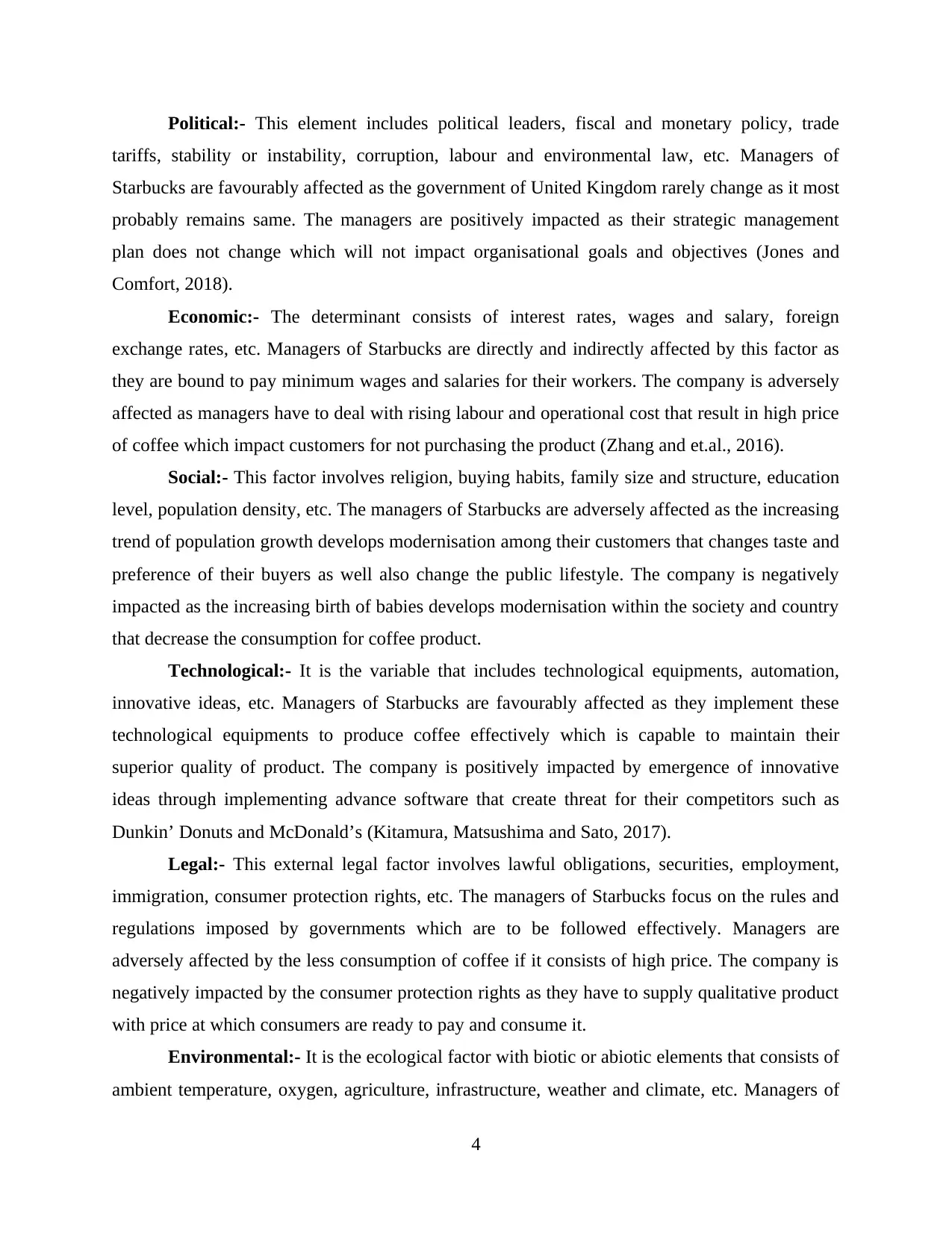
Political:- This element includes political leaders, fiscal and monetary policy, trade
tariffs, stability or instability, corruption, labour and environmental law, etc. Managers of
Starbucks are favourably affected as the government of United Kingdom rarely change as it most
probably remains same. The managers are positively impacted as their strategic management
plan does not change which will not impact organisational goals and objectives (Jones and
Comfort, 2018).
Economic:- The determinant consists of interest rates, wages and salary, foreign
exchange rates, etc. Managers of Starbucks are directly and indirectly affected by this factor as
they are bound to pay minimum wages and salaries for their workers. The company is adversely
affected as managers have to deal with rising labour and operational cost that result in high price
of coffee which impact customers for not purchasing the product (Zhang and et.al., 2016).
Social:- This factor involves religion, buying habits, family size and structure, education
level, population density, etc. The managers of Starbucks are adversely affected as the increasing
trend of population growth develops modernisation among their customers that changes taste and
preference of their buyers as well also change the public lifestyle. The company is negatively
impacted as the increasing birth of babies develops modernisation within the society and country
that decrease the consumption for coffee product.
Technological:- It is the variable that includes technological equipments, automation,
innovative ideas, etc. Managers of Starbucks are favourably affected as they implement these
technological equipments to produce coffee effectively which is capable to maintain their
superior quality of product. The company is positively impacted by emergence of innovative
ideas through implementing advance software that create threat for their competitors such as
Dunkin’ Donuts and McDonald’s (Kitamura, Matsushima and Sato, 2017).
Legal:- This external legal factor involves lawful obligations, securities, employment,
immigration, consumer protection rights, etc. The managers of Starbucks focus on the rules and
regulations imposed by governments which are to be followed effectively. Managers are
adversely affected by the less consumption of coffee if it consists of high price. The company is
negatively impacted by the consumer protection rights as they have to supply qualitative product
with price at which consumers are ready to pay and consume it.
Environmental:- It is the ecological factor with biotic or abiotic elements that consists of
ambient temperature, oxygen, agriculture, infrastructure, weather and climate, etc. Managers of
4
tariffs, stability or instability, corruption, labour and environmental law, etc. Managers of
Starbucks are favourably affected as the government of United Kingdom rarely change as it most
probably remains same. The managers are positively impacted as their strategic management
plan does not change which will not impact organisational goals and objectives (Jones and
Comfort, 2018).
Economic:- The determinant consists of interest rates, wages and salary, foreign
exchange rates, etc. Managers of Starbucks are directly and indirectly affected by this factor as
they are bound to pay minimum wages and salaries for their workers. The company is adversely
affected as managers have to deal with rising labour and operational cost that result in high price
of coffee which impact customers for not purchasing the product (Zhang and et.al., 2016).
Social:- This factor involves religion, buying habits, family size and structure, education
level, population density, etc. The managers of Starbucks are adversely affected as the increasing
trend of population growth develops modernisation among their customers that changes taste and
preference of their buyers as well also change the public lifestyle. The company is negatively
impacted as the increasing birth of babies develops modernisation within the society and country
that decrease the consumption for coffee product.
Technological:- It is the variable that includes technological equipments, automation,
innovative ideas, etc. Managers of Starbucks are favourably affected as they implement these
technological equipments to produce coffee effectively which is capable to maintain their
superior quality of product. The company is positively impacted by emergence of innovative
ideas through implementing advance software that create threat for their competitors such as
Dunkin’ Donuts and McDonald’s (Kitamura, Matsushima and Sato, 2017).
Legal:- This external legal factor involves lawful obligations, securities, employment,
immigration, consumer protection rights, etc. The managers of Starbucks focus on the rules and
regulations imposed by governments which are to be followed effectively. Managers are
adversely affected by the less consumption of coffee if it consists of high price. The company is
negatively impacted by the consumer protection rights as they have to supply qualitative product
with price at which consumers are ready to pay and consume it.
Environmental:- It is the ecological factor with biotic or abiotic elements that consists of
ambient temperature, oxygen, agriculture, infrastructure, weather and climate, etc. Managers of
4
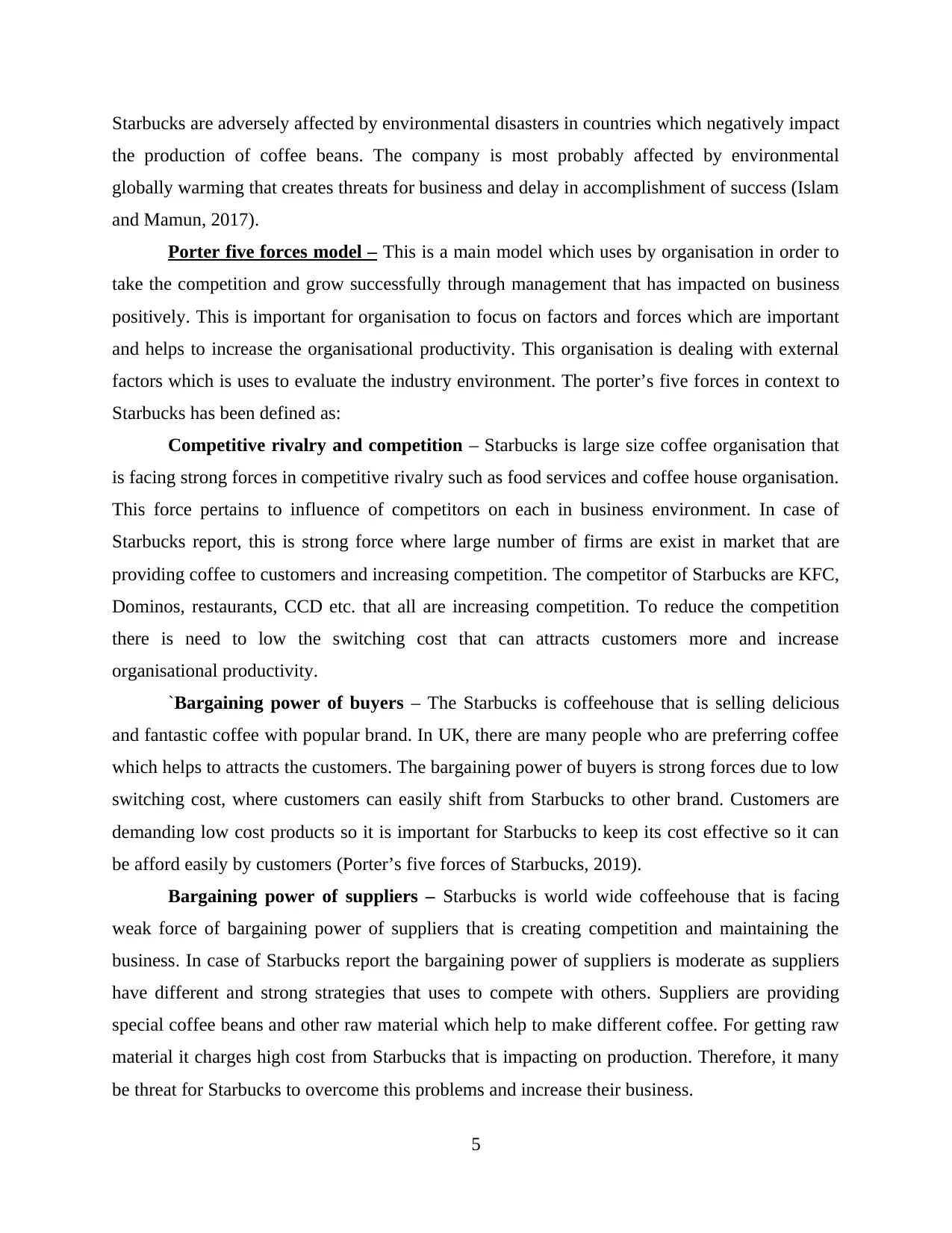
Starbucks are adversely affected by environmental disasters in countries which negatively impact
the production of coffee beans. The company is most probably affected by environmental
globally warming that creates threats for business and delay in accomplishment of success (Islam
and Mamun, 2017).
Porter five forces model – This is a main model which uses by organisation in order to
take the competition and grow successfully through management that has impacted on business
positively. This is important for organisation to focus on factors and forces which are important
and helps to increase the organisational productivity. This organisation is dealing with external
factors which is uses to evaluate the industry environment. The porter’s five forces in context to
Starbucks has been defined as:
Competitive rivalry and competition – Starbucks is large size coffee organisation that
is facing strong forces in competitive rivalry such as food services and coffee house organisation.
This force pertains to influence of competitors on each in business environment. In case of
Starbucks report, this is strong force where large number of firms are exist in market that are
providing coffee to customers and increasing competition. The competitor of Starbucks are KFC,
Dominos, restaurants, CCD etc. that all are increasing competition. To reduce the competition
there is need to low the switching cost that can attracts customers more and increase
organisational productivity.
`Bargaining power of buyers – The Starbucks is coffeehouse that is selling delicious
and fantastic coffee with popular brand. In UK, there are many people who are preferring coffee
which helps to attracts the customers. The bargaining power of buyers is strong forces due to low
switching cost, where customers can easily shift from Starbucks to other brand. Customers are
demanding low cost products so it is important for Starbucks to keep its cost effective so it can
be afford easily by customers (Porter’s five forces of Starbucks, 2019).
Bargaining power of suppliers – Starbucks is world wide coffeehouse that is facing
weak force of bargaining power of suppliers that is creating competition and maintaining the
business. In case of Starbucks report the bargaining power of suppliers is moderate as suppliers
have different and strong strategies that uses to compete with others. Suppliers are providing
special coffee beans and other raw material which help to make different coffee. For getting raw
material it charges high cost from Starbucks that is impacting on production. Therefore, it many
be threat for Starbucks to overcome this problems and increase their business.
5
the production of coffee beans. The company is most probably affected by environmental
globally warming that creates threats for business and delay in accomplishment of success (Islam
and Mamun, 2017).
Porter five forces model – This is a main model which uses by organisation in order to
take the competition and grow successfully through management that has impacted on business
positively. This is important for organisation to focus on factors and forces which are important
and helps to increase the organisational productivity. This organisation is dealing with external
factors which is uses to evaluate the industry environment. The porter’s five forces in context to
Starbucks has been defined as:
Competitive rivalry and competition – Starbucks is large size coffee organisation that
is facing strong forces in competitive rivalry such as food services and coffee house organisation.
This force pertains to influence of competitors on each in business environment. In case of
Starbucks report, this is strong force where large number of firms are exist in market that are
providing coffee to customers and increasing competition. The competitor of Starbucks are KFC,
Dominos, restaurants, CCD etc. that all are increasing competition. To reduce the competition
there is need to low the switching cost that can attracts customers more and increase
organisational productivity.
`Bargaining power of buyers – The Starbucks is coffeehouse that is selling delicious
and fantastic coffee with popular brand. In UK, there are many people who are preferring coffee
which helps to attracts the customers. The bargaining power of buyers is strong forces due to low
switching cost, where customers can easily shift from Starbucks to other brand. Customers are
demanding low cost products so it is important for Starbucks to keep its cost effective so it can
be afford easily by customers (Porter’s five forces of Starbucks, 2019).
Bargaining power of suppliers – Starbucks is world wide coffeehouse that is facing
weak force of bargaining power of suppliers that is creating competition and maintaining the
business. In case of Starbucks report the bargaining power of suppliers is moderate as suppliers
have different and strong strategies that uses to compete with others. Suppliers are providing
special coffee beans and other raw material which help to make different coffee. For getting raw
material it charges high cost from Starbucks that is impacting on production. Therefore, it many
be threat for Starbucks to overcome this problems and increase their business.
5
⊘ This is a preview!⊘
Do you want full access?
Subscribe today to unlock all pages.

Trusted by 1+ million students worldwide
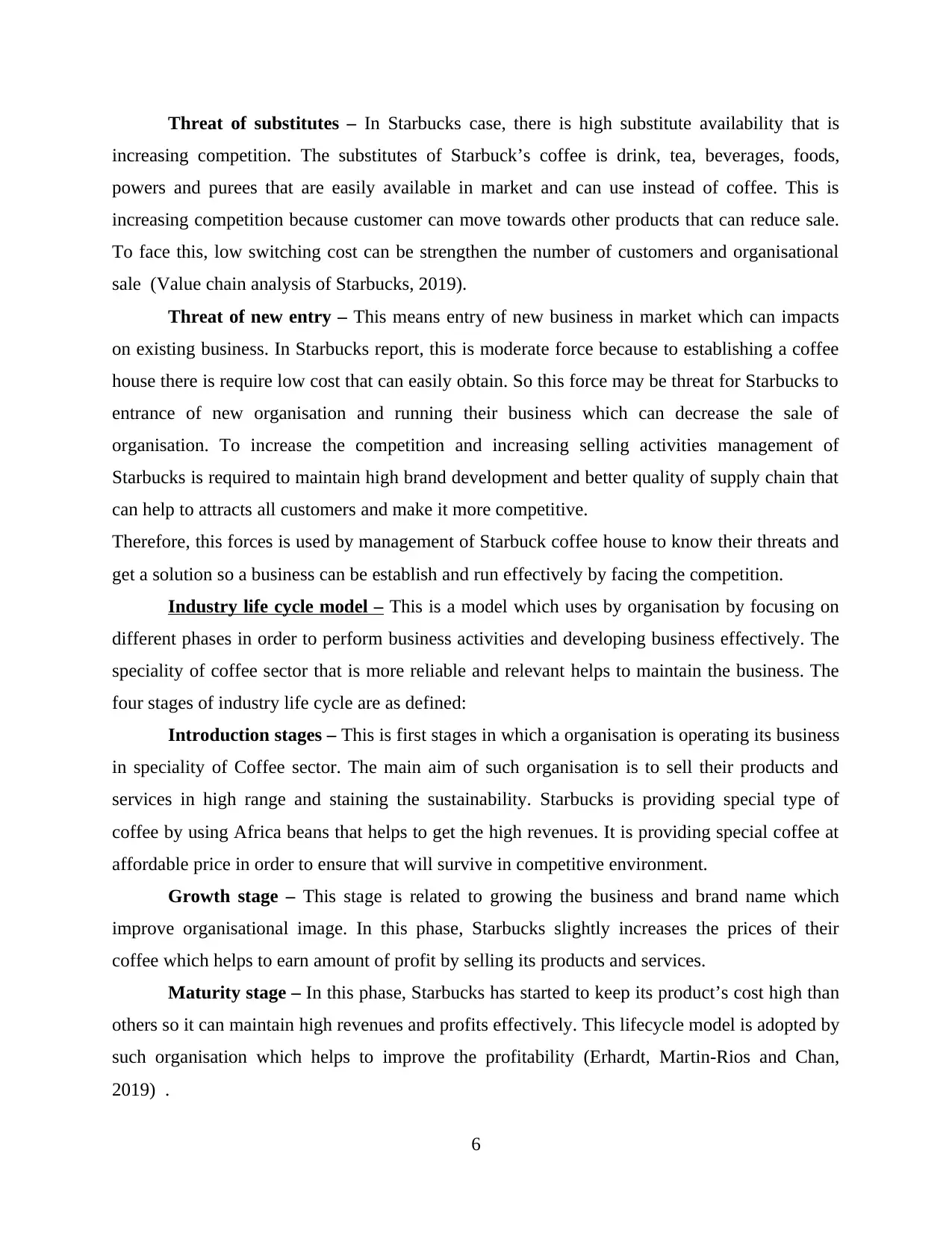
Threat of substitutes – In Starbucks case, there is high substitute availability that is
increasing competition. The substitutes of Starbuck’s coffee is drink, tea, beverages, foods,
powers and purees that are easily available in market and can use instead of coffee. This is
increasing competition because customer can move towards other products that can reduce sale.
To face this, low switching cost can be strengthen the number of customers and organisational
sale (Value chain analysis of Starbucks, 2019).
Threat of new entry – This means entry of new business in market which can impacts
on existing business. In Starbucks report, this is moderate force because to establishing a coffee
house there is require low cost that can easily obtain. So this force may be threat for Starbucks to
entrance of new organisation and running their business which can decrease the sale of
organisation. To increase the competition and increasing selling activities management of
Starbucks is required to maintain high brand development and better quality of supply chain that
can help to attracts all customers and make it more competitive.
Therefore, this forces is used by management of Starbuck coffee house to know their threats and
get a solution so a business can be establish and run effectively by facing the competition.
Industry life cycle model – This is a model which uses by organisation by focusing on
different phases in order to perform business activities and developing business effectively. The
speciality of coffee sector that is more reliable and relevant helps to maintain the business. The
four stages of industry life cycle are as defined:
Introduction stages – This is first stages in which a organisation is operating its business
in speciality of Coffee sector. The main aim of such organisation is to sell their products and
services in high range and staining the sustainability. Starbucks is providing special type of
coffee by using Africa beans that helps to get the high revenues. It is providing special coffee at
affordable price in order to ensure that will survive in competitive environment.
Growth stage – This stage is related to growing the business and brand name which
improve organisational image. In this phase, Starbucks slightly increases the prices of their
coffee which helps to earn amount of profit by selling its products and services.
Maturity stage – In this phase, Starbucks has started to keep its product’s cost high than
others so it can maintain high revenues and profits effectively. This lifecycle model is adopted by
such organisation which helps to improve the profitability (Erhardt, Martin-Rios and Chan,
2019) .
6
increasing competition. The substitutes of Starbuck’s coffee is drink, tea, beverages, foods,
powers and purees that are easily available in market and can use instead of coffee. This is
increasing competition because customer can move towards other products that can reduce sale.
To face this, low switching cost can be strengthen the number of customers and organisational
sale (Value chain analysis of Starbucks, 2019).
Threat of new entry – This means entry of new business in market which can impacts
on existing business. In Starbucks report, this is moderate force because to establishing a coffee
house there is require low cost that can easily obtain. So this force may be threat for Starbucks to
entrance of new organisation and running their business which can decrease the sale of
organisation. To increase the competition and increasing selling activities management of
Starbucks is required to maintain high brand development and better quality of supply chain that
can help to attracts all customers and make it more competitive.
Therefore, this forces is used by management of Starbuck coffee house to know their threats and
get a solution so a business can be establish and run effectively by facing the competition.
Industry life cycle model – This is a model which uses by organisation by focusing on
different phases in order to perform business activities and developing business effectively. The
speciality of coffee sector that is more reliable and relevant helps to maintain the business. The
four stages of industry life cycle are as defined:
Introduction stages – This is first stages in which a organisation is operating its business
in speciality of Coffee sector. The main aim of such organisation is to sell their products and
services in high range and staining the sustainability. Starbucks is providing special type of
coffee by using Africa beans that helps to get the high revenues. It is providing special coffee at
affordable price in order to ensure that will survive in competitive environment.
Growth stage – This stage is related to growing the business and brand name which
improve organisational image. In this phase, Starbucks slightly increases the prices of their
coffee which helps to earn amount of profit by selling its products and services.
Maturity stage – In this phase, Starbucks has started to keep its product’s cost high than
others so it can maintain high revenues and profits effectively. This lifecycle model is adopted by
such organisation which helps to improve the profitability (Erhardt, Martin-Rios and Chan,
2019) .
6
Paraphrase This Document
Need a fresh take? Get an instant paraphrase of this document with our AI Paraphraser
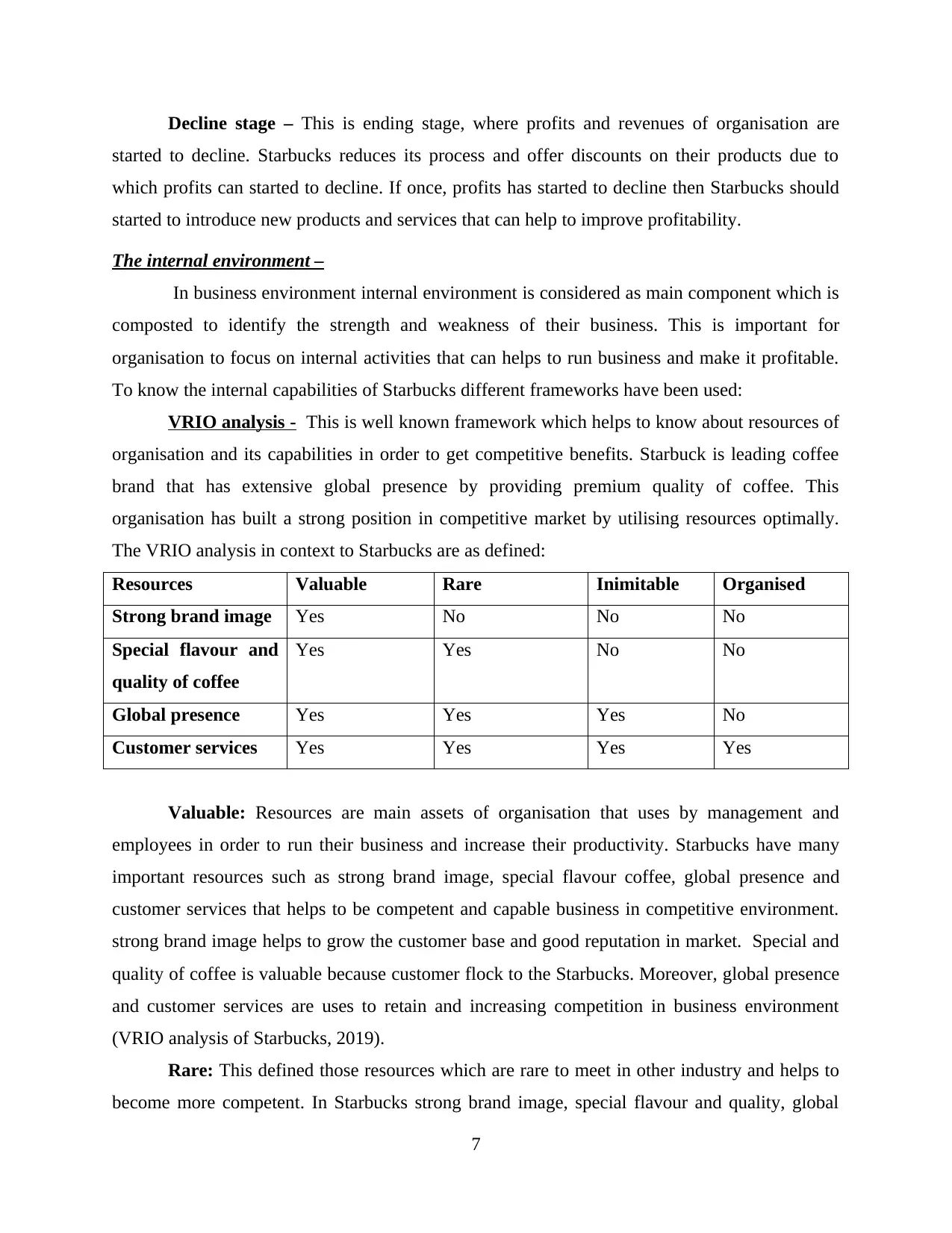
Decline stage – This is ending stage, where profits and revenues of organisation are
started to decline. Starbucks reduces its process and offer discounts on their products due to
which profits can started to decline. If once, profits has started to decline then Starbucks should
started to introduce new products and services that can help to improve profitability.
The internal environment –
In business environment internal environment is considered as main component which is
composted to identify the strength and weakness of their business. This is important for
organisation to focus on internal activities that can helps to run business and make it profitable.
To know the internal capabilities of Starbucks different frameworks have been used:
VRIO analysis - This is well known framework which helps to know about resources of
organisation and its capabilities in order to get competitive benefits. Starbuck is leading coffee
brand that has extensive global presence by providing premium quality of coffee. This
organisation has built a strong position in competitive market by utilising resources optimally.
The VRIO analysis in context to Starbucks are as defined:
Resources Valuable Rare Inimitable Organised
Strong brand image Yes No No No
Special flavour and
quality of coffee
Yes Yes No No
Global presence Yes Yes Yes No
Customer services Yes Yes Yes Yes
Valuable: Resources are main assets of organisation that uses by management and
employees in order to run their business and increase their productivity. Starbucks have many
important resources such as strong brand image, special flavour coffee, global presence and
customer services that helps to be competent and capable business in competitive environment.
strong brand image helps to grow the customer base and good reputation in market. Special and
quality of coffee is valuable because customer flock to the Starbucks. Moreover, global presence
and customer services are uses to retain and increasing competition in business environment
(VRIO analysis of Starbucks, 2019).
Rare: This defined those resources which are rare to meet in other industry and helps to
become more competent. In Starbucks strong brand image, special flavour and quality, global
7
started to decline. Starbucks reduces its process and offer discounts on their products due to
which profits can started to decline. If once, profits has started to decline then Starbucks should
started to introduce new products and services that can help to improve profitability.
The internal environment –
In business environment internal environment is considered as main component which is
composted to identify the strength and weakness of their business. This is important for
organisation to focus on internal activities that can helps to run business and make it profitable.
To know the internal capabilities of Starbucks different frameworks have been used:
VRIO analysis - This is well known framework which helps to know about resources of
organisation and its capabilities in order to get competitive benefits. Starbuck is leading coffee
brand that has extensive global presence by providing premium quality of coffee. This
organisation has built a strong position in competitive market by utilising resources optimally.
The VRIO analysis in context to Starbucks are as defined:
Resources Valuable Rare Inimitable Organised
Strong brand image Yes No No No
Special flavour and
quality of coffee
Yes Yes No No
Global presence Yes Yes Yes No
Customer services Yes Yes Yes Yes
Valuable: Resources are main assets of organisation that uses by management and
employees in order to run their business and increase their productivity. Starbucks have many
important resources such as strong brand image, special flavour coffee, global presence and
customer services that helps to be competent and capable business in competitive environment.
strong brand image helps to grow the customer base and good reputation in market. Special and
quality of coffee is valuable because customer flock to the Starbucks. Moreover, global presence
and customer services are uses to retain and increasing competition in business environment
(VRIO analysis of Starbucks, 2019).
Rare: This defined those resources which are rare to meet in other industry and helps to
become more competent. In Starbucks strong brand image, special flavour and quality, global
7
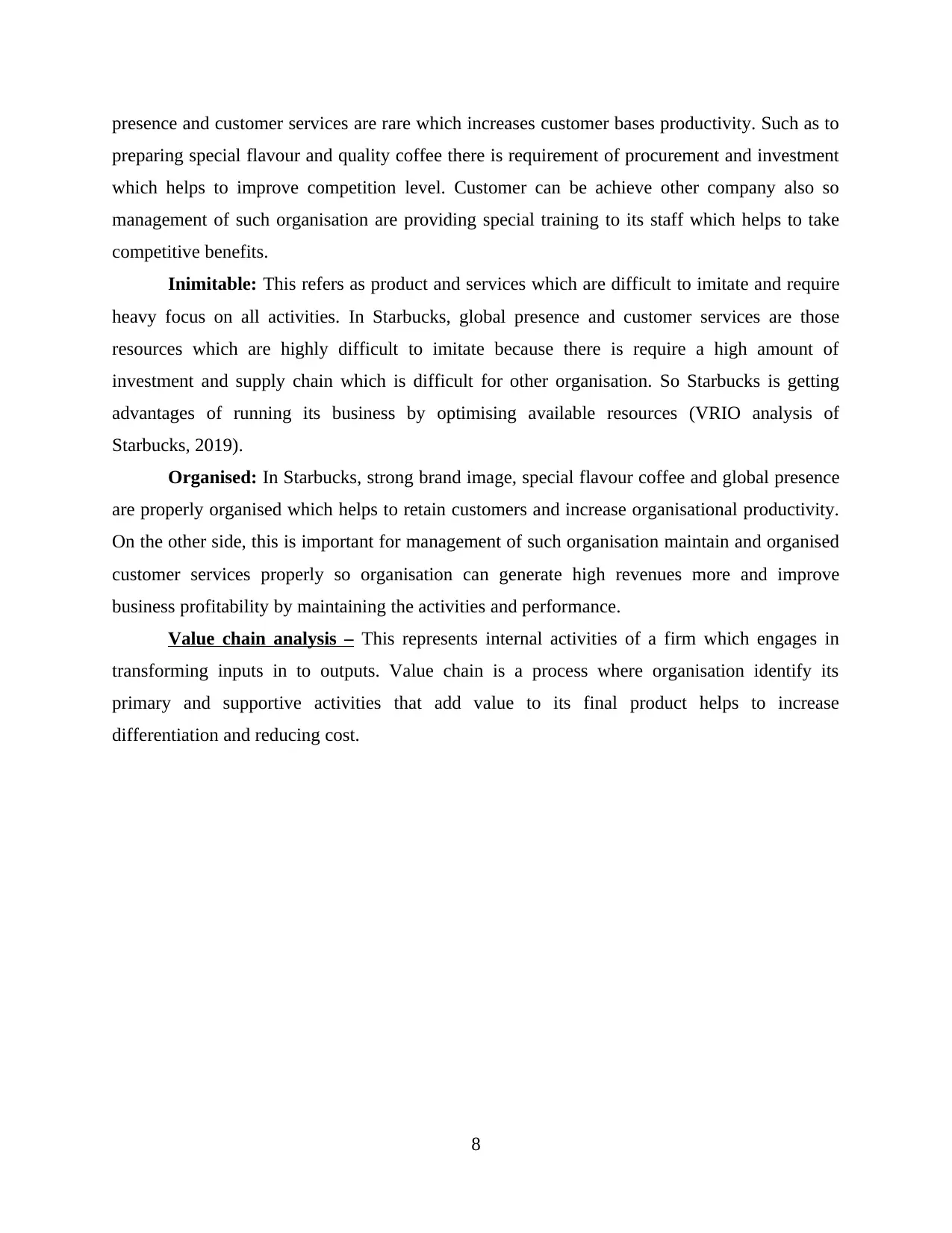
presence and customer services are rare which increases customer bases productivity. Such as to
preparing special flavour and quality coffee there is requirement of procurement and investment
which helps to improve competition level. Customer can be achieve other company also so
management of such organisation are providing special training to its staff which helps to take
competitive benefits.
Inimitable: This refers as product and services which are difficult to imitate and require
heavy focus on all activities. In Starbucks, global presence and customer services are those
resources which are highly difficult to imitate because there is require a high amount of
investment and supply chain which is difficult for other organisation. So Starbucks is getting
advantages of running its business by optimising available resources (VRIO analysis of
Starbucks, 2019).
Organised: In Starbucks, strong brand image, special flavour coffee and global presence
are properly organised which helps to retain customers and increase organisational productivity.
On the other side, this is important for management of such organisation maintain and organised
customer services properly so organisation can generate high revenues more and improve
business profitability by maintaining the activities and performance.
Value chain analysis – This represents internal activities of a firm which engages in
transforming inputs in to outputs. Value chain is a process where organisation identify its
primary and supportive activities that add value to its final product helps to increase
differentiation and reducing cost.
8
preparing special flavour and quality coffee there is requirement of procurement and investment
which helps to improve competition level. Customer can be achieve other company also so
management of such organisation are providing special training to its staff which helps to take
competitive benefits.
Inimitable: This refers as product and services which are difficult to imitate and require
heavy focus on all activities. In Starbucks, global presence and customer services are those
resources which are highly difficult to imitate because there is require a high amount of
investment and supply chain which is difficult for other organisation. So Starbucks is getting
advantages of running its business by optimising available resources (VRIO analysis of
Starbucks, 2019).
Organised: In Starbucks, strong brand image, special flavour coffee and global presence
are properly organised which helps to retain customers and increase organisational productivity.
On the other side, this is important for management of such organisation maintain and organised
customer services properly so organisation can generate high revenues more and improve
business profitability by maintaining the activities and performance.
Value chain analysis – This represents internal activities of a firm which engages in
transforming inputs in to outputs. Value chain is a process where organisation identify its
primary and supportive activities that add value to its final product helps to increase
differentiation and reducing cost.
8
⊘ This is a preview!⊘
Do you want full access?
Subscribe today to unlock all pages.

Trusted by 1+ million students worldwide
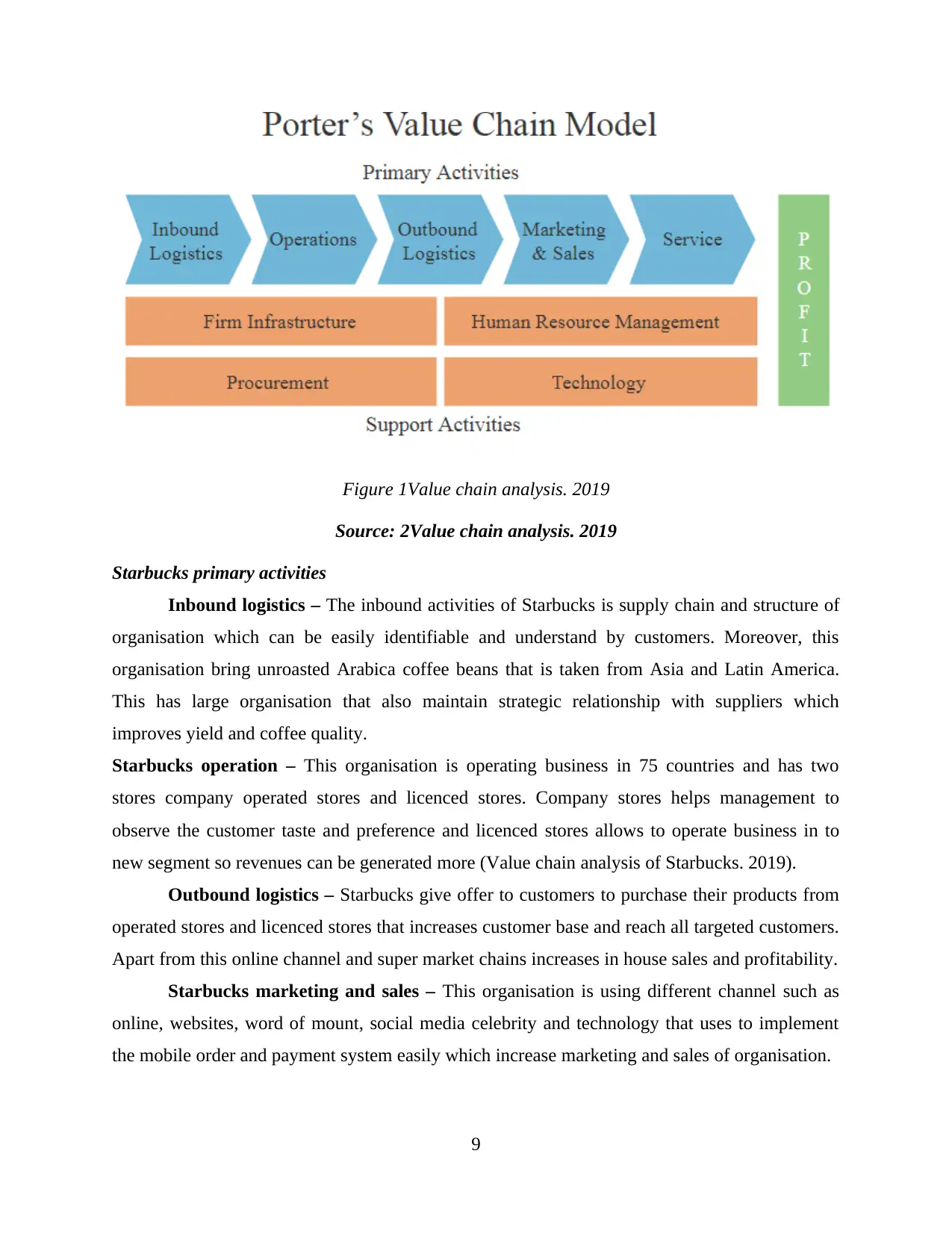
Figure 1Value chain analysis. 2019
Source: 2Value chain analysis. 2019
Starbucks primary activities
Inbound logistics – The inbound activities of Starbucks is supply chain and structure of
organisation which can be easily identifiable and understand by customers. Moreover, this
organisation bring unroasted Arabica coffee beans that is taken from Asia and Latin America.
This has large organisation that also maintain strategic relationship with suppliers which
improves yield and coffee quality.
Starbucks operation – This organisation is operating business in 75 countries and has two
stores company operated stores and licenced stores. Company stores helps management to
observe the customer taste and preference and licenced stores allows to operate business in to
new segment so revenues can be generated more (Value chain analysis of Starbucks. 2019).
Outbound logistics – Starbucks give offer to customers to purchase their products from
operated stores and licenced stores that increases customer base and reach all targeted customers.
Apart from this online channel and super market chains increases in house sales and profitability.
Starbucks marketing and sales – This organisation is using different channel such as
online, websites, word of mount, social media celebrity and technology that uses to implement
the mobile order and payment system easily which increase marketing and sales of organisation.
9
Source: 2Value chain analysis. 2019
Starbucks primary activities
Inbound logistics – The inbound activities of Starbucks is supply chain and structure of
organisation which can be easily identifiable and understand by customers. Moreover, this
organisation bring unroasted Arabica coffee beans that is taken from Asia and Latin America.
This has large organisation that also maintain strategic relationship with suppliers which
improves yield and coffee quality.
Starbucks operation – This organisation is operating business in 75 countries and has two
stores company operated stores and licenced stores. Company stores helps management to
observe the customer taste and preference and licenced stores allows to operate business in to
new segment so revenues can be generated more (Value chain analysis of Starbucks. 2019).
Outbound logistics – Starbucks give offer to customers to purchase their products from
operated stores and licenced stores that increases customer base and reach all targeted customers.
Apart from this online channel and super market chains increases in house sales and profitability.
Starbucks marketing and sales – This organisation is using different channel such as
online, websites, word of mount, social media celebrity and technology that uses to implement
the mobile order and payment system easily which increase marketing and sales of organisation.
9
Paraphrase This Document
Need a fresh take? Get an instant paraphrase of this document with our AI Paraphraser
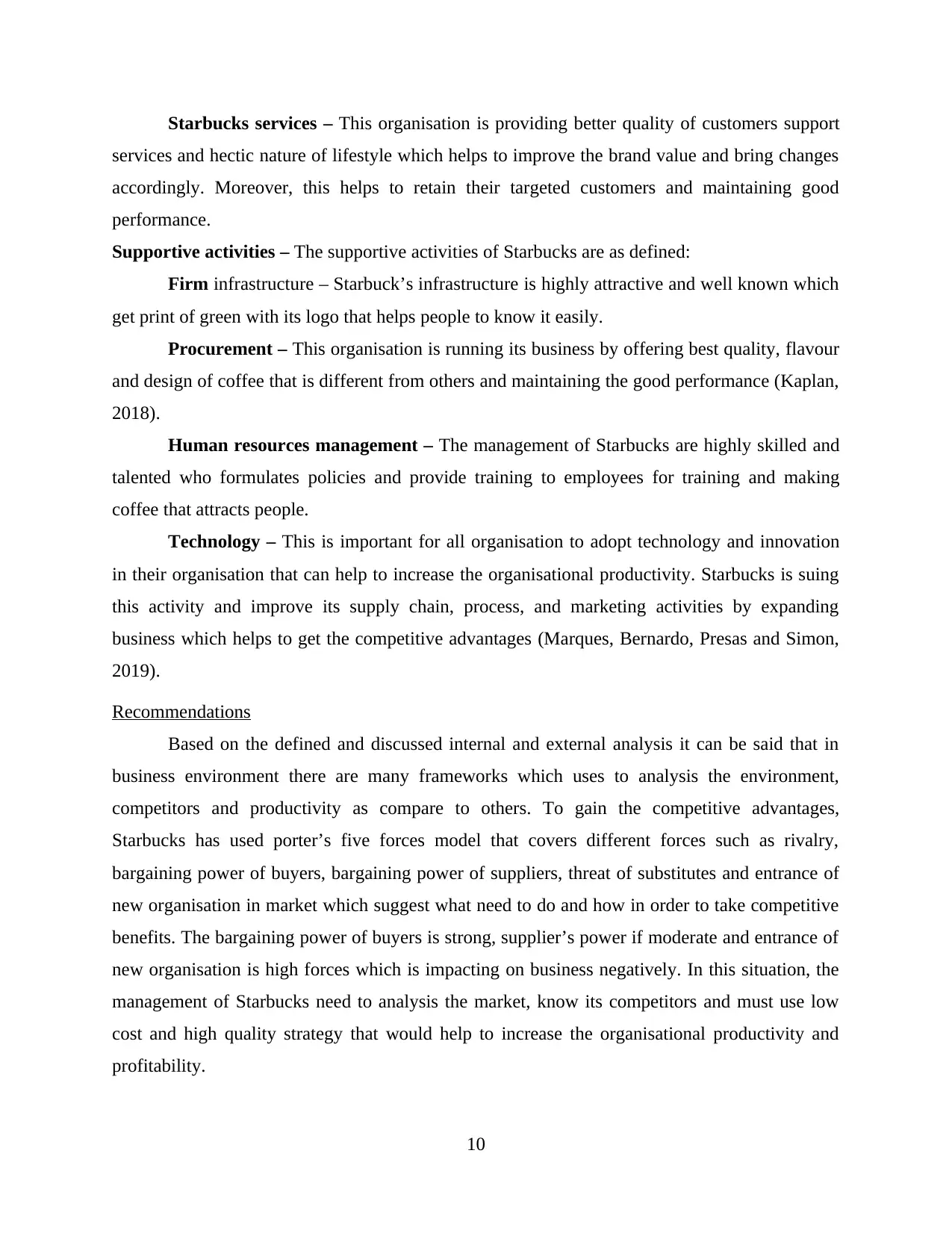
Starbucks services – This organisation is providing better quality of customers support
services and hectic nature of lifestyle which helps to improve the brand value and bring changes
accordingly. Moreover, this helps to retain their targeted customers and maintaining good
performance.
Supportive activities – The supportive activities of Starbucks are as defined:
Firm infrastructure – Starbuck’s infrastructure is highly attractive and well known which
get print of green with its logo that helps people to know it easily.
Procurement – This organisation is running its business by offering best quality, flavour
and design of coffee that is different from others and maintaining the good performance (Kaplan,
2018).
Human resources management – The management of Starbucks are highly skilled and
talented who formulates policies and provide training to employees for training and making
coffee that attracts people.
Technology – This is important for all organisation to adopt technology and innovation
in their organisation that can help to increase the organisational productivity. Starbucks is suing
this activity and improve its supply chain, process, and marketing activities by expanding
business which helps to get the competitive advantages (Marques, Bernardo, Presas and Simon,
2019).
Recommendations
Based on the defined and discussed internal and external analysis it can be said that in
business environment there are many frameworks which uses to analysis the environment,
competitors and productivity as compare to others. To gain the competitive advantages,
Starbucks has used porter’s five forces model that covers different forces such as rivalry,
bargaining power of buyers, bargaining power of suppliers, threat of substitutes and entrance of
new organisation in market which suggest what need to do and how in order to take competitive
benefits. The bargaining power of buyers is strong, supplier’s power if moderate and entrance of
new organisation is high forces which is impacting on business negatively. In this situation, the
management of Starbucks need to analysis the market, know its competitors and must use low
cost and high quality strategy that would help to increase the organisational productivity and
profitability.
10
services and hectic nature of lifestyle which helps to improve the brand value and bring changes
accordingly. Moreover, this helps to retain their targeted customers and maintaining good
performance.
Supportive activities – The supportive activities of Starbucks are as defined:
Firm infrastructure – Starbuck’s infrastructure is highly attractive and well known which
get print of green with its logo that helps people to know it easily.
Procurement – This organisation is running its business by offering best quality, flavour
and design of coffee that is different from others and maintaining the good performance (Kaplan,
2018).
Human resources management – The management of Starbucks are highly skilled and
talented who formulates policies and provide training to employees for training and making
coffee that attracts people.
Technology – This is important for all organisation to adopt technology and innovation
in their organisation that can help to increase the organisational productivity. Starbucks is suing
this activity and improve its supply chain, process, and marketing activities by expanding
business which helps to get the competitive advantages (Marques, Bernardo, Presas and Simon,
2019).
Recommendations
Based on the defined and discussed internal and external analysis it can be said that in
business environment there are many frameworks which uses to analysis the environment,
competitors and productivity as compare to others. To gain the competitive advantages,
Starbucks has used porter’s five forces model that covers different forces such as rivalry,
bargaining power of buyers, bargaining power of suppliers, threat of substitutes and entrance of
new organisation in market which suggest what need to do and how in order to take competitive
benefits. The bargaining power of buyers is strong, supplier’s power if moderate and entrance of
new organisation is high forces which is impacting on business negatively. In this situation, the
management of Starbucks need to analysis the market, know its competitors and must use low
cost and high quality strategy that would help to increase the organisational productivity and
profitability.
10
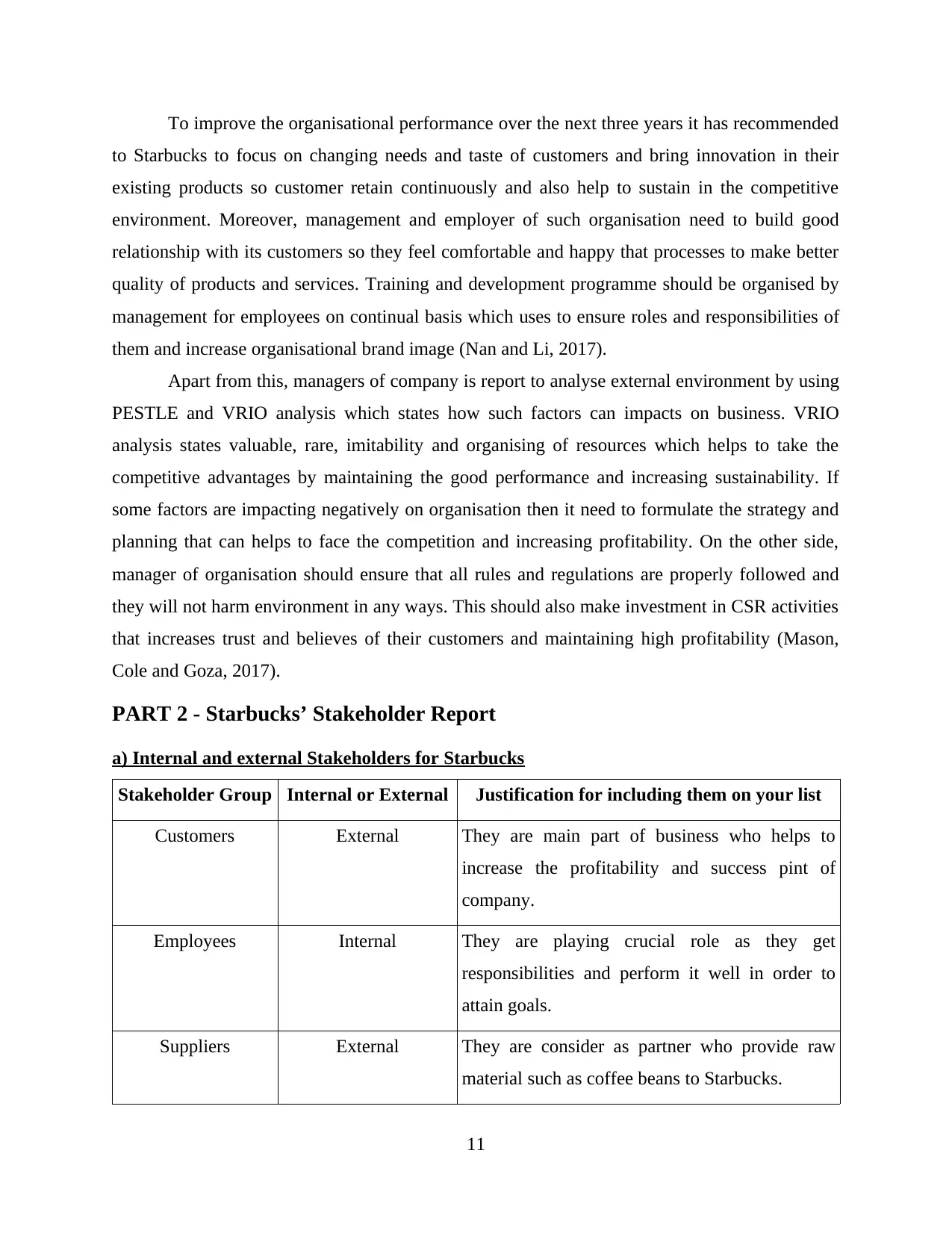
To improve the organisational performance over the next three years it has recommended
to Starbucks to focus on changing needs and taste of customers and bring innovation in their
existing products so customer retain continuously and also help to sustain in the competitive
environment. Moreover, management and employer of such organisation need to build good
relationship with its customers so they feel comfortable and happy that processes to make better
quality of products and services. Training and development programme should be organised by
management for employees on continual basis which uses to ensure roles and responsibilities of
them and increase organisational brand image (Nan and Li, 2017).
Apart from this, managers of company is report to analyse external environment by using
PESTLE and VRIO analysis which states how such factors can impacts on business. VRIO
analysis states valuable, rare, imitability and organising of resources which helps to take the
competitive advantages by maintaining the good performance and increasing sustainability. If
some factors are impacting negatively on organisation then it need to formulate the strategy and
planning that can helps to face the competition and increasing profitability. On the other side,
manager of organisation should ensure that all rules and regulations are properly followed and
they will not harm environment in any ways. This should also make investment in CSR activities
that increases trust and believes of their customers and maintaining high profitability (Mason,
Cole and Goza, 2017).
PART 2 - Starbucks’ Stakeholder Report
a) Internal and external Stakeholders for Starbucks
Stakeholder Group Internal or External Justification for including them on your list
Customers External They are main part of business who helps to
increase the profitability and success pint of
company.
Employees Internal They are playing crucial role as they get
responsibilities and perform it well in order to
attain goals.
Suppliers External They are consider as partner who provide raw
material such as coffee beans to Starbucks.
11
to Starbucks to focus on changing needs and taste of customers and bring innovation in their
existing products so customer retain continuously and also help to sustain in the competitive
environment. Moreover, management and employer of such organisation need to build good
relationship with its customers so they feel comfortable and happy that processes to make better
quality of products and services. Training and development programme should be organised by
management for employees on continual basis which uses to ensure roles and responsibilities of
them and increase organisational brand image (Nan and Li, 2017).
Apart from this, managers of company is report to analyse external environment by using
PESTLE and VRIO analysis which states how such factors can impacts on business. VRIO
analysis states valuable, rare, imitability and organising of resources which helps to take the
competitive advantages by maintaining the good performance and increasing sustainability. If
some factors are impacting negatively on organisation then it need to formulate the strategy and
planning that can helps to face the competition and increasing profitability. On the other side,
manager of organisation should ensure that all rules and regulations are properly followed and
they will not harm environment in any ways. This should also make investment in CSR activities
that increases trust and believes of their customers and maintaining high profitability (Mason,
Cole and Goza, 2017).
PART 2 - Starbucks’ Stakeholder Report
a) Internal and external Stakeholders for Starbucks
Stakeholder Group Internal or External Justification for including them on your list
Customers External They are main part of business who helps to
increase the profitability and success pint of
company.
Employees Internal They are playing crucial role as they get
responsibilities and perform it well in order to
attain goals.
Suppliers External They are consider as partner who provide raw
material such as coffee beans to Starbucks.
11
⊘ This is a preview!⊘
Do you want full access?
Subscribe today to unlock all pages.

Trusted by 1+ million students worldwide
1 out of 17
Related Documents
Your All-in-One AI-Powered Toolkit for Academic Success.
+13062052269
info@desklib.com
Available 24*7 on WhatsApp / Email
![[object Object]](/_next/static/media/star-bottom.7253800d.svg)
Unlock your academic potential
Copyright © 2020–2025 A2Z Services. All Rights Reserved. Developed and managed by ZUCOL.





